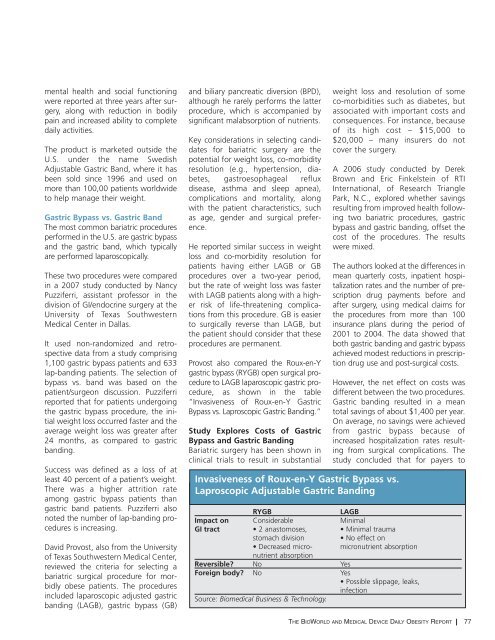You also want an ePaper? Increase the reach of your titles
YUMPU automatically turns print PDFs into web optimized ePapers that Google loves.
mental health and social functioning<br />
were reported at three years after surgery,<br />
along with reduction in bodily<br />
pain and increased ability to complete<br />
daily activities.<br />
The product is marketed outside the<br />
U.S. under the name Swedish<br />
Adjustable Gastric Band, where it has<br />
been sold since 1996 and used on<br />
more than 100,00 patients worldwide<br />
to help manage their weight.<br />
Gastric Bypass vs. Gastric Band<br />
The most common bariatric procedures<br />
performed in the U.S. are gastric bypass<br />
and the gastric band, which typically<br />
are performed laparoscopically.<br />
These two procedures were compared<br />
in a 2007 study conducted by Nancy<br />
Puzziferri, assistant professor in the<br />
division of GI/endocrine surgery at the<br />
University of Texas Southwestern<br />
<strong>Medical</strong> Center in Dallas.<br />
It used non-randomized and retrospective<br />
data from a study comprising<br />
1,100 gastric bypass patients and 633<br />
lap-banding patients. The selection of<br />
bypass vs. band was based on the<br />
patient/surgeon discussion. Puzziferri<br />
reported that for patients undergoing<br />
the gastric bypass procedure, the initial<br />
weight loss occurred faster and the<br />
average weight loss was greater after<br />
24 months, as compared to gastric<br />
banding.<br />
Success was defined as a loss of at<br />
least 40 percent of a patient’s weight.<br />
There was a higher attrition rate<br />
among gastric bypass patients than<br />
gastric band patients. Puzziferri also<br />
noted the number of lap-banding procedures<br />
is increasing.<br />
David Provost, also from the University<br />
of Texas Southwestern <strong>Medical</strong> Center,<br />
reviewed the criteria for selecting a<br />
bariatric surgical procedure for morbidly<br />
obese patients. The procedures<br />
included laparoscopic adjusted gastric<br />
banding (LAGB), gastric bypass (GB)<br />
and biliary pancreatic diversion (BPD),<br />
although he rarely performs the latter<br />
procedure, which is accompanied by<br />
significant malabsorption of nutrients.<br />
Key considerations in selecting candidates<br />
for bariatric surgery are the<br />
potential for weight loss, co-morbidity<br />
resolution (e.g., hypertension, diabetes,<br />
gastroesophageal reflux<br />
disease, asthma and sleep apnea),<br />
complications and mortality, along<br />
with the patient characteristics, such<br />
as age, gender and surgical preference.<br />
He reported similar success in weight<br />
loss and co-morbidity resolution for<br />
patients having either LAGB or GB<br />
procedures over a two-year period,<br />
but the rate of weight loss was faster<br />
with LAGB patients along with a higher<br />
risk of life-threatening complications<br />
from this procedure. GB is easier<br />
to surgically reverse than LAGB, but<br />
the patient should consider that these<br />
procedures are permanent.<br />
Provost also compared the Roux-en-Y<br />
gastric bypass (RYGB) open surgical procedure<br />
to LAGB laparoscopic gastric procedure,<br />
as shown in the table<br />
“Invasiveness of Roux-en-Y Gastric<br />
Bypass vs. Laproscopic Gastric Banding.”<br />
Study Explores Costs of Gastric<br />
Bypass and Gastric Banding<br />
Bariatric surgery has been shown in<br />
clinical trials to result in substantial<br />
weight loss and resolution of some<br />
co-morbidities such as diabetes, but<br />
associated with important costs and<br />
consequences. For instance, because<br />
of its high cost – $15,000 to<br />
$20,000 – many insurers do not<br />
cover the surgery.<br />
A 2006 study conducted by Derek<br />
Brown and Eric Finkelstein of RTI<br />
International, of Research Triangle<br />
Park, N.C., explored whether savings<br />
resulting from improved health following<br />
two bariatric procedures, gastric<br />
bypass and gastric banding, offset the<br />
cost of the procedures. The results<br />
were mixed.<br />
The authors looked at the differences in<br />
mean quarterly costs, inpatient hospitalization<br />
rates and the number of prescription<br />
drug payments before and<br />
after surgery, using medical claims for<br />
the procedures from more than 100<br />
insurance plans during the period of<br />
2001 to 2004. The data showed that<br />
both gastric banding and gastric bypass<br />
achieved modest reductions in prescription<br />
drug use and post-surgical costs.<br />
However, the net effect on costs was<br />
different between the two procedures.<br />
Gastric banding resulted in a mean<br />
total savings of about $1,400 per year.<br />
On average, no savings were achieved<br />
from gastric bypass because of<br />
increased hospitalization rates resulting<br />
from surgical complications. The<br />
study concluded that for payers to<br />
Invasiveness of Roux-en-Y Gastric Bypass vs.<br />
Laproscopic Adjustable Gastric Banding<br />
RYGB LAGB<br />
Impact on Considerable Minimal<br />
GI tract 2 anastomoses, Minimal trauma<br />
stomach division No effect on<br />
Decreased micro- micronutrient absorption<br />
nutrient absorption<br />
Reversible? No Yes<br />
Foreign body? No Yes<br />
Possible slippage, leaks,<br />
infection<br />
Source: Biomedical Business & Technology.<br />
THE BIOWORLD AND MEDICAL DEVICE DAILY OBESITY REPORT 77

















